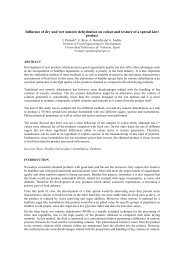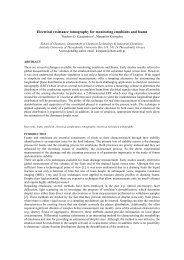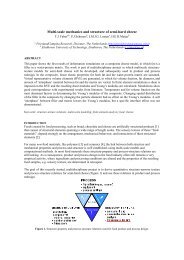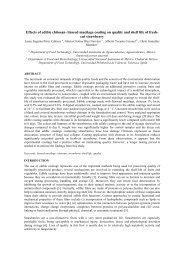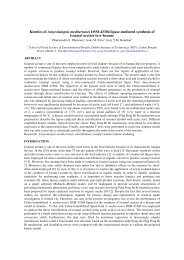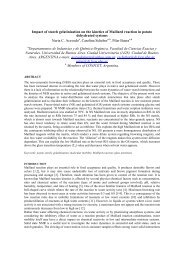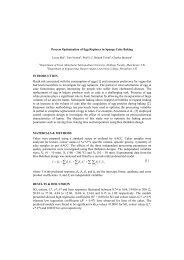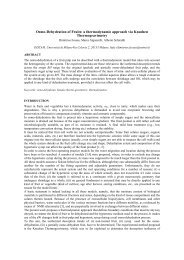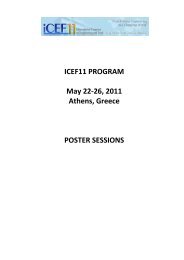The antioxidant properties of honey beer
The antioxidant properties of honey beer
The antioxidant properties of honey beer
You also want an ePaper? Increase the reach of your titles
YUMPU automatically turns print PDFs into web optimized ePapers that Google loves.
MATERIALS & METHODS<br />
<strong>The</strong> wort and bottom-fermenting yeast used in this study were obtained from a local brewery. Two types <strong>of</strong><br />
<strong>honey</strong>, sunflower and linden <strong>honey</strong>, were purchased from local market. Control <strong>beer</strong> was produced by<br />
fermenting pure wort without adding <strong>of</strong> <strong>honey</strong>.<br />
Gallic acid, Folin-Ciocalteu’s phenol reagent, ammonium hydroxide, hydrochloric acid, sodium acetate<br />
trihydrate, glacial acetic acid, ammonium ferric citrate and sodium carbonate, carboxylmethylcellulose<br />
(CMC) and sodium ethylendiamintetraacetate (EDTA) were purchased from Merck (Germany). Ascorbic<br />
acid, 2,4,6-trypyridyl-s-triazine (TPTZ), ferric chloride hexahydrate, 2,2-diphenyl-1-picrylhydrazyl (DPPH),<br />
6-hydroxy-2,5,7,8-tetramethylchroman-2-carboxylic acid (Trolox ® ), sodium dihydrogen phosphate, sodium<br />
hydrogen phosphate, sodium chloride, potassium persulfate were purchased from Sigma-Aldrich (Germany).<br />
Determination <strong>of</strong> total phenolics:<br />
Folin-Ciocalteau method: For the determination <strong>of</strong> total polyphenols the adjusted method with Folin-<br />
Ciocalteau reagent was used [8]. Degassed samples <strong>of</strong> <strong>beer</strong> (0.05 mL) were mixed with 0.45 mL <strong>of</strong> distilled<br />
water and 2,5 mL <strong>of</strong> 10-fold diluted Folin-Ciocalteu’s phenol reagent and allowed to react for 5 min. Two<br />
milliliters <strong>of</strong> saturated sodium carbonate (75 g/L) was added to the mixture and then shaken. After 2 h <strong>of</strong><br />
reaction at room temperature, the absorbance at 760 nm was determined. <strong>The</strong> measurement was compared to<br />
a calibration line <strong>of</strong> prepared gallic acid (GA) solution, and the results were expressed as milligrams <strong>of</strong> gallic<br />
acid equivalents per liter <strong>of</strong> <strong>beer</strong> (mg GAE/L). All determinations were performed in triplicate.<br />
EBC method [9]: Into 25 mL volumetric flask to 10 mL <strong>of</strong> <strong>beer</strong> sample, 8 mL <strong>of</strong><br />
carboxylmethylcellulose/sodium ethylendiamintetraacetate (CMC/EDTA) and 0.5 mL 3.5% ammonium<br />
ferriccitrate solutions were added. After thorough agitation 0.5 mL dilute ammonia solution was added and<br />
after agitation the flasks were adjusted with distilled water till the mark. After 10 minutes standing at<br />
laboratory temperature absorbance <strong>of</strong> samples was measured on the spectrophotometer (Jenway 6400) at<br />
wavelength λ = 600 nm. Ammonium ferric citrate solution: 3.5 g ammonium ferric citrate was diluted in<br />
water in 100 ml volumetric flask. Ammonia solution: 1 part <strong>of</strong> concentrated ammonia solution was diluted in<br />
2 parts <strong>of</strong> distilled water. TP was calculated as TP = A 600 × 820, where TP are total phenolics (mg/L) and<br />
A 600 is measured absorbance. Average results were obtained from triplicate determinations.<br />
Antioxidant capacity:<br />
DPPH· method: Antiradical activity was measured after the reaction with free stable radical 1,1-diphenyl-2-<br />
picrylhydrazyl (DPPH・) according to Brand-Williams [10]. Fresh solution <strong>of</strong> DPPH in the concentration <strong>of</strong><br />
25 mg DPPH in 1L <strong>of</strong> methanol should be prepared before the determination. 3 mL <strong>of</strong> violet DPPH solution<br />
is pipette into plastic cuvettes <strong>of</strong> 10 mm length and absorbance is measured at wavelength λ = 515 nm on the<br />
spectrophotometer (Jenway 6400). <strong>The</strong>n 5 μL <strong>of</strong> sample is added and after stir with the hand stirrer in<br />
cuvettes the reaction mixture is left to stand for 30 min. <strong>The</strong> measurements were performed in triplicate. <strong>The</strong><br />
radical scavenging activity was calculated by the formula I = [(A B − A A )/A B ] × 100; where I = DPPH<br />
inhibition, %; A B = absorption <strong>of</strong> a blank sample (t = 0 min); A A = absorption <strong>of</strong> a tested <strong>honey</strong> <strong>beer</strong>s at the<br />
chosen point <strong>of</strong> the reaction (t = 30 min).<br />
FRAP assay: On FRAP assay, 25.0 mL <strong>of</strong> acetate buffer (pH= 3.65) were mixed with 2.5 mL <strong>of</strong> TPTZ,<br />
2.5 mL <strong>of</strong> FeCl 3·6H 2 O. TPTZ solution was dissolved in HCl at 1900 μL <strong>of</strong> the previously described reagent<br />
was mixed with 100 μL <strong>of</strong> sample, and 100 μL <strong>of</strong> deionised water in a cuvette cell. This mixture was kept at<br />
25 °C. Absorbance readings were made at 593 nm every 4 min. For determination <strong>of</strong> <strong>antioxidant</strong> activity <strong>of</strong><br />
samples calibration curve was used. Results were expressed as mM Fe(II)SO 4 x 7H 2 O [11].



